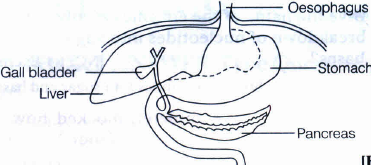CBSE 11th Standard Biology Subject Digestion and Absorption HOT Questions 2 Marks Questions With Solution 2021
By QB365 on 29 May, 2021
QB365 Provides the HOT Question Papers for Class 11 Biology, and also provide the detail solution for each and every HOT Questions. HOT Questions will help to get more idea about question pattern in every exams and also will help to get more marks in Exams
QB365 - Question Bank Software
CBSE 11th Standard Biology Subject Digestion and Absorption HOT Questions 2 Marks Questions With Solution 2021
11th Standard CBSE
-
Reg.No. :
Biology
-
'Digestion of starch starts in the buccal cavity, but stops in the stomach'. Comment
(a) -
Where does the absorption of drugs start in human alimentary canal?
(a) -
Why is the egestion process of food necessary?
(a) -
HCI is a strong acid. Yet it does not corrode the walls of the stomach. Why?
(a) -
Mention the importance of chemical analysis of liver in postmortem.
(a) -
Bile juice contains no digestive enzymes, yet it is important for digestion.Why?
(a) -
How is the intestial mucosa protected from the acidic food passing from stomach?
(a) -
The diagram shows part of the human alimentary canal.Which two structures produce substances involved in the digestion of fats?
 (a)
(a) -
Certain drugs are absorbed through layers of the buccal cavity. What is the terminology for this kind of absorption?
(a) -
In case of dysentery people feel a sense of weakness. What may be the reason for this?
(a)
2 Marks
*****************************************
CBSE 11th Standard Biology Subject Digestion and Absorption HOT Questions 2 Marks Questions With Solution 2021 Answer Keys
-
Starch is not digested in the stomach, because the enzyme ptyalin (salivary amylase) that is used in its digestion cannot survive in the acidic (low) pH of the stomach due to the presence of HCl.
-
A soon as the drug comes in contact with mucosa of mouth and lower side of the tongue, it is absorbed by the blood capillaries.Some drugs are also absorbed in large intestine.
-
As the digestive waste reaches the rectum,it gets accumulated in rectum.If it is not excreted out through egestion process, It will intoxicate the whole body.
-
The HCI produced in the stomach is not as strong as used for industrial purposes.
However, acidic behavior of HCI does not corrode the stomach walls, because the gastric epithelium of stomach is secretory in nature, i.e., it produces mucus, which covers the stomach wall preventing it from corrosive action of gastric juice. -
The food which has been digested and absorbed by the blood passes through the liver. A person, who consumed some poisonous substance, its traces would naturally go to the liver.
Hence, liver cells are chemically examined during postmortem to know the content of the cells of liver. -
Bile is a yellowish green alkaline solution with 89-98% water, it has no digestive enzymes.the bile released into the duodenum contains bile pigments(bilirubin and biliverdin), bile salts, cholesterol and phospholipids, but no enzymes.Bile helps in emulsification of fats, i.e breaking down of the fats into very small micelles.Bile also activates lipases.
-
The mucosa is secreated by the goblet cells.It also mixes with the bicarbonates from the pancreas.These protect the intestinal mucosa from acid food.It also provides an alkaline medium(pH-7.8) for pancreatic enzyme activities.Submucosal glands(Brunner's glands) also help in this action.
-
Bile is produced by the liver and pancreatic juice is secreted by pancreas.Liver and pancreas are the two glands of alimentary canal these produce substances (enzymes and bile free) involved in the digestion of fat.
-
Sublingual.
-
Excess dehydration leads to loss of salts from the body. This disturbs the electrolyte balance of the body.
2 Marks



































